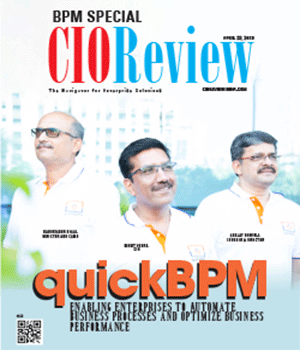
Business Process Improvements in a GST Scenario
V. Balasundaram, Director (Finance) and Board Member, Frost & Sullivan (India) | Monday, 18 September 2017, 11:36 IST
 The mind of any CFO or CIO today in India is completely occupied by the biggest tax reform so far of the country –the Goods and Services Tax (GST). The introduction of GST is expected to have a profound impact on the business process management of all companies. This is because a perusal of the GST requirements reveals that the provisions require elaborate reporting to the government. While an elaborate reporting takes its time and efforts, it appears that it has also opened up possibilities of an increase in business process efficiency of all companies.
The mind of any CFO or CIO today in India is completely occupied by the biggest tax reform so far of the country –the Goods and Services Tax (GST). The introduction of GST is expected to have a profound impact on the business process management of all companies. This is because a perusal of the GST requirements reveals that the provisions require elaborate reporting to the government. While an elaborate reporting takes its time and efforts, it appears that it has also opened up possibilities of an increase in business process efficiency of all companies.
The main report under GST is GSTR-1, which gives the details of sales invoices of a company for any particular month. Every company registered under GST has to report to the government invoice-wise details of taxable value and the tax amount, among other things. The requirement to give details document-wise increases the amount of data transmitted to the government manifold. Another important return that needs to be submitted is GSTR-2, which gives details of invoices from vendors. Here again, the company has to give the details invoice-wise, and hence the amount of data to be submitted is huge. However, the company need not prepare GSTR-2 from scratch. The government would present the company with a Draft GSTR-2, styled as GSTR-2A. This is possible since GSTR-2 is a return of purchase invoices, which are nothing but sales invoices of others who would report all details invoice-wise in their GSTR-1. The company needs to basically review GSTR-2A and modify it to rectify any mistakes and finalize it as GSTR-2.Since the company would essentially be presented with GSTR-2A with almost all data culled from various reports of vendors, the task of submitting GSTR-2 is not expected to be big.
This situation presents us with some interesting possibilities, in terms of business process management.
The effect on small companies which process their accounting data on a monthly basis and the effect on big companies which process documents real-time would however be different.
To see the possibilities with respect to small companies, let us assume that a company has 300 sales invoices and 500 purchase invoices to process. Assuming a normal situation, a total of 800 documents would be keyed into the accounting systems of the company. Data relating to the 300 sales invoices would then be extracted from the accounting systems and GSTR- 1 would be prepared based on that and filed. Also, GSTR-2A would be checked with the data in the accounting systems relating to the 500 purchase invoices, and finalized for submission as GSTR-2. Now, since invoice-wise data of purchase invoices are made available to the company by the government, it may make sense to explore if keying in of the 500 purchase invoices can be avoided in future. The company can simply download all purchase data from the GSTN system of the government, verify that with the documents already received from the vendors for payment, and finalize GSTR-2 after making any rectifications required. Once that is done, the same data can be simply uploaded into the company’s accounting system, which will completely avoid keying in the purchase data. If that can be achieved, it will mean a very significant saving in the time, efforts and cost required in getting the purchase data into the system.
As for big companies processing documents on real-time basis, I believe that the new GST scenario will result in a big boost to Electronic Data Interchange (EDI) processes, once the nationwide GST implementation process settles down. A big company will have thousands of purchase invoices processed in its ERP system every month. And, when it gets its GSTR-2A for verification, it will find out the differences between its own data and the data as submitted by its vendors. The company will just have a few days to finalize their GSRT- 2 and submit it, making changes as it deems fit. It can then take up the task of rectifying the situation, by contacting the vendors in connection with whom mistakes have been noted. There is a legal deadline by which the mismatches will have to be sorted out; otherwise, the company will have to add the tax amount in question to its output tax liability, and pay it to the government. Considering that the volume would be very high, with probably hundreds of vendors to be dealt with, the company may not be able to set right the mistakes within the legal deadline, resulting in an unnecessary tax payment, which can be really huge. To avoid this unnecessary payment, it makes sense to start the process of identifying the mismatches at the earliest possible opportunity. An EDI system would give the best chance of avoiding this issue, since it will bring out any mismatch at the earliest possible time frame, that is, even before the end of the month and even before GSTR-1 is filed by the vendors. Hence, I believe that EDI projects will get a big boost after GST implementation is complete and trade and industry fully understand how things work under GST.
CIO Viewpoint
Enabling An Effective Workforce With The Proper...
By Daniel M. Horton, CIO, Sallyport Global
Three Ways To Build A Gmail Security Conscious...
By Niraj Ranjan Rout, Co-founder & CEO, Hiver
By Sreenivas Pamidimukkala, CIO, International Paper
CXO Insights
Looking towards Operations Management: What...
By Dr. Vandana Sonwaney, Director, SIOM
Strategic Implementation And Control
By SURESH.V. MENON-PRINCIPAL CONSULTANT SIX SIGMA & STRATEGIC MANAGEMENT, ADVISORY (BUSINESS EXCELLENCE)
Grand Strategies Used In Strategic Management









